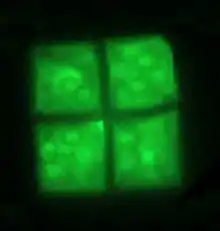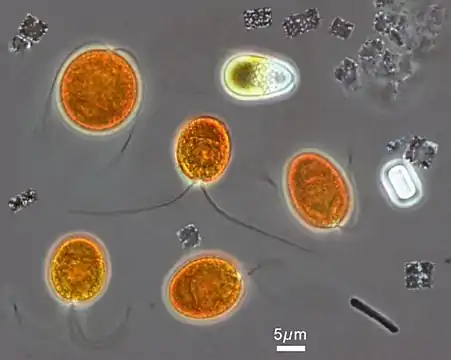Haloquadratum walsbyi
Haloquadratum walsbyi is of the genus Haloquadratum, within the archaea domain. First discovered in a brine pool in the Sinai peninsula of Egypt, H. walsbyi is noted for its flat, square-shaped cells, and its unusual ability to survive in aqueous environments with high concentrations of sodium chloride and magnesium chloride.[1][2] The species' genus name Haloquadratum translates from Greek and Latin as "salt square". In accordance with its name, Haloquadratum walsbyi are most abundantly observed in salty environments.
| Haloquadratum walsbyi | |
|---|---|
 | |
| Scientific classification | |
| Domain: | |
| Phylum: | |
| Class: | |
| Order: | |
| Family: | |
| Genus: | |
| Species: | H. walsbyi |
| Binomial name | |
| Haloquadratum walsbyi Burns et al. 2007 | |
Haloquadratum walsbyi is a phototrophic halophilic archaeon. It was the only recognized species of the genus Haloquadratum until 1999 when Haloarcula quadrata was reported as recovered from a brine pool.[1] Haloquadratum walsbyi is very unusual because of its unique cellular structure that resembles an almost-perfectly, flat-shaped figure.
The genus was first observed in 1980 by a British microbiologist, Prof. Anthony E. Walsby, from samples taken from the Sabkha Gavish, a brine lake in southern Sinai, Egypt. This discovery is formally described in 2007 by Burns et al. Attempts to cultivate the archaea were unsuccessful until 2004 and resulted in the identification of Haloarcula quadrata, another species of square archaea of the genus Haloarcula, distinct from H. walsbyi, less abundant and genetically quite different.
Description
Haloquadratum walsbyi cells size at 2 to 5 microns and 100 to 200 nanometers thick. The archaea generally contain granules of polyhydroxyalkanoates and hold a number of refractive vacuoles filled with gas that ensure buoyancy in an aqueous environment, and allow for maximum light absorption. They gather in sheets up to 40 μm wide, but the connections between the cells are fragile and can easily be broken.[3]
These organisms can be found in any stretch of very salty water. During the evaporation of seawater, calcium carbonate (CaCO3) and calcium sulfate (CaSO4) precipitate first, leading to a brine rich in sodium chloride NaCl. If evaporation continues, NaCl precipitates in the form of halite, leaving a brine rich in magnesium chloride (MgCl2). H. walsbyi prospers during the final phase of the precipitation of halite, and can constitute 80% of the biomass of this medium.
The genome of H. walsbyi has been completely sequenced, allowing access to a better understanding of the phylogenetic and taxonomic classification of this organism and its role in the ecosystem. A genomic comparison of Spanish and Australian isolates (strains HBSQ001 and C23T) strongly suggests a rapid global dispersion, as they are remarkably similar and have maintained the order of genes.
Its growth in the laboratory was obtained in a medium with very high chloride concentrations (greater than 2 mol · L−1 of MgCl2 and greater than 3 mol · L −1of NaCl ), making this organism among the most haloresistant known. Its optimum growth temperature is 40 °C, making this archaea a Mesophile.
 Optical phase-contrast microscopy image of a Haloquadratum walsbyi square cell. The numerous light dots are gas vesicles that allow flotation to the surface, most likely to acquire oxygen.[4]Scale bar 1 µm
Optical phase-contrast microscopy image of a Haloquadratum walsbyi square cell. The numerous light dots are gas vesicles that allow flotation to the surface, most likely to acquire oxygen.[4]Scale bar 1 µm Microscopic image from the hypersaline Lake Tyrrell, in which orange chlorophyte Dunaliella salina can be tentatively identified, accompanied by a number of smaller Haloquadratum walsbyi, showing their flat square-shaped cells.
Microscopic image from the hypersaline Lake Tyrrell, in which orange chlorophyte Dunaliella salina can be tentatively identified, accompanied by a number of smaller Haloquadratum walsbyi, showing their flat square-shaped cells.
Diversity
Genomics and Structure
H. walsbyi is classified as an oligotrophic microorganism, as it grows in nutrient deficient conditions where concentrations of organic substances are minimal. To combat, H. walsbyi maintains a high surface to volume ratio by flattening to maximize nutrient uptake. Because of their square shape, they are more capable of flattening than spherical shaped microorganisms are.[2]
A typical Genome of H. walsbyi has a 3,132,494 bp chromosome. The strain HBSQ001, DSM 16790 was analyzed to obtain this data. H. walsbyi is distinguished by the abnormally low Guanine-Cytosine (GC) content compared to other haloarchaea. H. walsbyi has an average of 47.9% GC content compared to the expected 60-70%. Additionally, the proteins encoded are highly conserved specifically in the amino acid sequence. It is understood that H. walsbyi evolved from a typical GC rich, moderately conserving ancestor.[2]
History
The Haloquadratum walsbyi archaea was first discovered in 1980 by a microbiology professor named Anthony E. Walsby.[5] This organism was initially named after him as “Walsby's square bacterium” due to its discovery occurring before the archaea domain was truly acknowledged.[6] It is now formally known as Haloquadratum walsbyi, a well known halophilic archaeon that is considered to be one of first archaea discovered with a square cellular shape.[7]
In 2004, two strains of H. walsbyi were successfully isolated and able to be sequenced. The first strain is an isolate from the Spanish, called HBSQ00.[5] The second strain is an Australian isolate, called C23.[5]
Normal Microbiota
The Archaeon Haloquadratum walsbyi is abundant in red brines, in salt lakes and solar salter crystallizer ponds,[8] shallow ponds that are connected to each other and increase in salinity.[9] Bacteriorhodopsin, a membrane protein that uses energy from light to drive the hydrogen-ion pump,[10] which are found in Haloquadratum walsbyi absorbs energy from light and are found in communities within these brines.[8] The use of these bacteriorhodopsin shows the photoheterotroph nature of Haloquadratum walsbyi .
References
- Oren A, Ventosa A, Gutiérrez MC, Kamekura M (July 1999). "Haloarcula quadrata sp. nov., a square, motile archaeon isolated from a brine pool in Sinai (Egypt)". International Journal of Systematic Bacteriology. 49 (3): 1149–1155. doi:10.1099/00207713-49-3-1149. PMID 10425773.
- Bolhuis H, Palm P, Wende A, Falb M, Rampp M, Rodriguez-Valera F, et al. (July 2006). "The genome of the square archaeon Haloquadratum walsbyi : life at the limits of water activity". BMC Genomics. 7 (1): 169. doi:10.1186/1471-2164-7-169. PMC 1544339. PMID 16820047.
- Sublimi Saponetti M, Bobba F, Salerno G, Scarfato A, Corcelli A, Cucolo A (April 2011). "Morphological and structural aspects of the extremely halophilic archaeon Haloquadratum walsbyi". PLOS ONE. 6 (4): e18653. Bibcode:2011PLoSO...618653S. doi:10.1371/journal.pone.0018653. PMC 3084702. PMID 21559517.
- Sublimi Saponetti M, Bobba F, Salerno G, Scarfato A, Corcelli A, Cucolo A (April 2011). "Morphological and structural aspects of the extremely halophilic archaeon Haloquadratum walsbyi". Plos One. 6 (4): e18653. doi:10.1371/journal.pone.0018653. PMC 3084702. PMID 21559517.
- Bolhuis H, Martín-Cuadrado AB, Rosselli R, Pašić L, Rodriguez-Valera F (July 2017). "Transcriptome analysis of Haloquadratum walsbyi: vanity is but the surface". BMC Genomics. 18 (1): 510. doi:10.1186/s12864-017-3892-2. PMC 5496347. PMID 28673248.
- Legault BA, Lopez-Lopez A, Alba-Casado JC, Doolittle WF, Bolhuis H, Rodriguez-Valera F, Papke RT (July 2006). "Environmental genomics of "Haloquadratum walsbyi" in a saltern crystallizer indicates a large pool of accessory genes in an otherwise coherent species". BMC Genomics. 7 (1): 171. doi:10.1186/1471-2164-7-171. PMC 1560387. PMID 16820057.
- Lobasso S, Lopalco P, Mascolo G, Corcelli A (December 2008). "Lipids of the ultra-thin square halophilic archaeon Haloquadratum walsbyi". Archaea. 2 (3): 177–183. doi:10.1155/2008/870191. PMC 2685597. PMID 19054744.
- "Haloquadratum walsbyi - an overview | ScienceDirect Topics". www.sciencedirect.com. Retrieved 2022-10-27.
- Antón, Josefa; Rosselló-Mora, Ramón; Rodríguez-Valera, Francisco; Amann, Rudolf (July 2000). "Extremely Halophilic Bacteria in Crystallizer Ponds from Solar Salterns". Applied and Environmental Microbiology. 66 (7): 3052–3057. doi:10.1128/aem.66.7.3052-3057.2000. ISSN 0099-2240.
- Henderson, R.; Schertler, G. F. (1990-01-30). "The structure of bacteriorhodopsin and its relevance to the visual opsins and other seven-helix G-protein coupled receptors". Philosophical Transactions of the Royal Society of London. Series B, Biological Sciences. 326 (1236): 379–389. doi:10.1098/rstb.1990.0019. ISSN 0962-8436. PMID 1970644.
Further reading
- Lobasso S, Lopalco P, Vitale R, Saponetti MS, Capitanio G, Mangini V, et al. (9 February 2012). "The light-activated proton pump Bop I of the archaeon Haloquadratum walsbyi". Photochemistry and Photobiology. 88 (3): 690–700. doi:10.1111/j.1751-1097.2012.01089.x. PMID 22248212. S2CID 41934280.
- Cuebas-Irizarry MF, Irizarry-Caro RA, López-Morales C, Badillo-Rivera KM, Rodríguez-Minguela CM, Montalvo-Rodríguez R (November 2017). "Cloning and Molecular Characterization of an Alpha-Glucosidase (MalH) from the Halophilic Archaeon Haloquadratum walsbyi". Life. 7 (4): 46. doi:10.3390/life7040046. PMC 5745559. PMID 29160840.